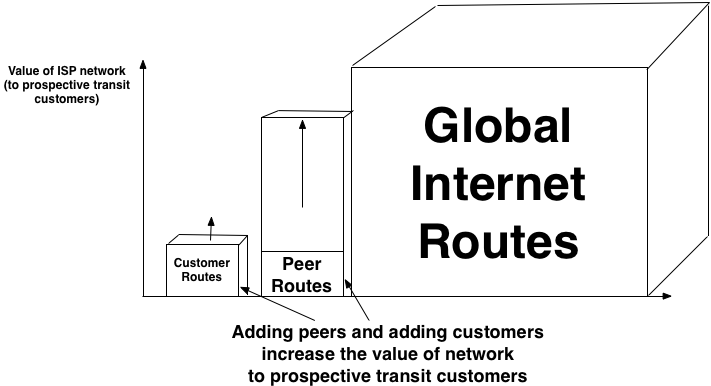We documented the value of an Internet Exchange Point before:
Value of the IXP = ValueDerived - CostToParticipate
Value of the IXP = f(p, r, v, m) - c
where on the value side:
p = the number of participants at the IXP—the "How many?"
r = the number and uniqueness of routes available at the IXP—the "Who there?"
v = the volume of traffic that is peered at the IXP—the "How much?"
m = the match of the service to the market needs and stickiness—the "Why are they there?"
Is there a way to estimate and model the value of an Internet Transit network?
I tie the value of an Internet Transit Network to the value derived by the customer base. It is a similar logic to the value of the IX formula you mention above.
When an ISP, let's call him "ISP A," purchases Internet Transit from an upstream ISP, it is buying access to the part of the global Internet that it can not reach by itself. In some Internet Regions around the world, most Internet traffic is predominantly coming from the U.S. or Europe, so most of the value of the Internet Transit network is derived from the quality of its network capacity up to its upstream Internet Transit provider, and the quality of the global routes it picks up there.
The rest of the value of ISP A is derived from the value of its customer routes and the value of its peer routes; these routes allow traffic to be offloaded directly from its network.
A typical value allocation is shown in the Figure 1 below.

Figure 1 - The value of an Internet Transit network to its prospective customers.
Since the Internet is always growing, the amount of traffic pushed or pulled to an Internet Region tends to grow, and the value of peering that traffic away for free tends to grow. So let's consider what happens to this value of an Internet Transit Network as an individual Internet Peering Ecosystems grows.
The ISP A network is a more attractive network to its transit customers when it peers its traffic locally (see the middle column in the figure). Why? Peering provides ISP A's customers with direct access to ISP A's peers' customers. This means that customers get better performance when their traffic doesn't have to go all the way up to an ISP A's upstream transit provider to be served!
As the ecosystem develops, more local ISPs and more local content comes on-line, so the value of ISP A's Internet Transit network increases as it peers this traffic locally.
From a marketing perspective, the performance benefits become a more important differentiator in this ecosystem, and from a public relations perspective, peering positions ISP A as promoting the regional Internet. By evangelizing peering, ISP A will lead to customers to not only demand great access to the global Internet, but to also demand great performance to these increasingly important local routes.
The ISP A network is a more attractive network to its transit customers as it obtains more customers as well. Why? First, the performance is even better when all customer traffic can be satisfied entirely on the same network. Second, these routes may be unique; if the customers are singly-homed to ISP A, the next best alternative to reach these customers might require sending this traffic through ISP A's upstream transit provider. Therefore, a compelling argument can be made that purchasing transit from ISP A will provide the best performing path to these local destinations.
As the ecosystem develops, these local peer and customer routes (the left two columns in the diagram above) become even more important.
So the value of the Internet Transit Network routes can be estimated with functions:
RouteQualityValue=Quality(customer routes)+Q(peer routes)+Q(global routes)
I would suggest that the first two parameters are more valuable and therefore might even be weighted.
To get to the value of the Internet Transit Network, the value of the routes is then multiplied by the traffic volume and mix, which is itself an indicator of the value of the routes to these transit network customers.
ValueNetwork=f(TrafficVolumeMix, RouteQualityValue)
These are very broad strokes but this is how I tend to think about it.